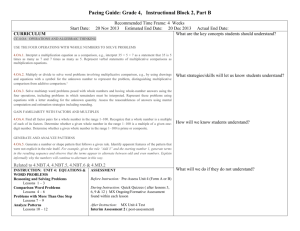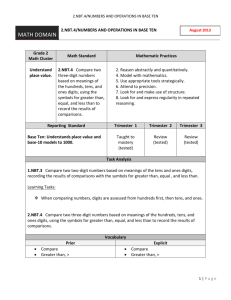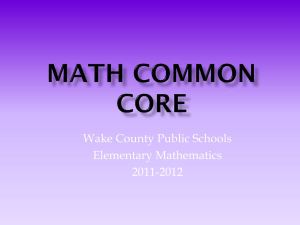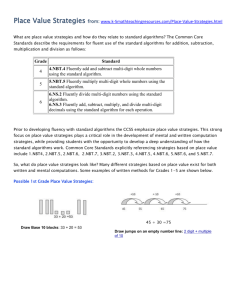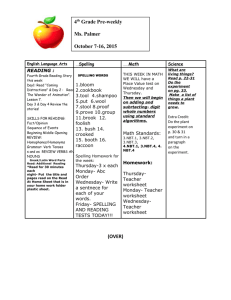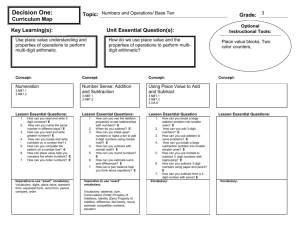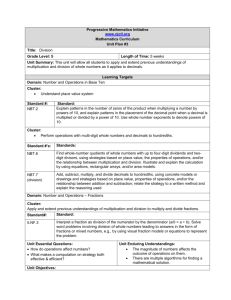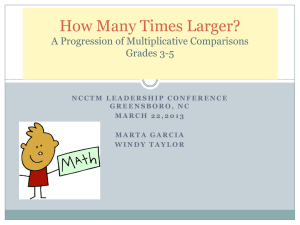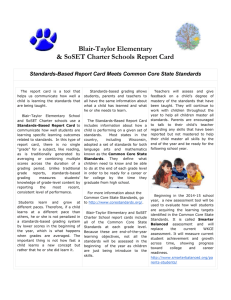5th Grade Unit 1 Lesson Sequence
advertisement
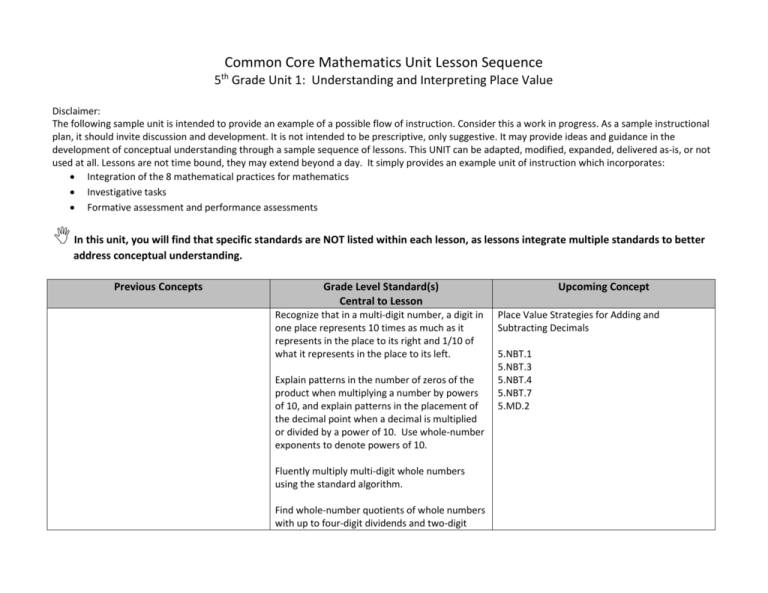
Common Core Mathematics Unit Lesson Sequence th 5 Grade Unit 1: Understanding and Interpreting Place Value Disclaimer: The following sample unit is intended to provide an example of a possible flow of instruction. Consider this a work in progress. As a sample instructional plan, it should invite discussion and development. It is not intended to be prescriptive, only suggestive. It may provide ideas and guidance in the development of conceptual understanding through a sample sequence of lessons. This UNIT can be adapted, modified, expanded, delivered as-is, or not used at all. Lessons are not time bound, they may extend beyond a day. It simply provides an example unit of instruction which incorporates: Integration of the 8 mathematical practices for mathematics Investigative tasks Formative assessment and performance assessments In this unit, you will find that specific standards are NOT listed within each lesson, as lessons integrate multiple standards to better address conceptual understanding. Previous Concepts Grade Level Standard(s) Central to Lesson Recognize that in a multi-digit number, a digit in one place represents 10 times as much as it represents in the place to its right and 1/10 of what it represents in the place to its left. Explain patterns in the number of zeros of the product when multiplying a number by powers of 10, and explain patterns in the placement of the decimal point when a decimal is multiplied or divided by a power of 10. Use whole-number exponents to denote powers of 10. Fluently multiply multi-digit whole numbers using the standard algorithm. Find whole-number quotients of whole numbers with up to four-digit dividends and two-digit Upcoming Concept Place Value Strategies for Adding and Subtracting Decimals 5.NBT.1 5.NBT.3 5.NBT.4 5.NBT.7 5.MD.2 divisors, using strategies based on place value, the properties of operations and/or the relationship between multiplication and division. Illustrate and explain the calculation by using equations, rectangular arrays and/or area models. Use parentheses, brackets or braces in numerical expressions and evaluate expressions with these symbols. Write simple expressions that record calculations with numbers and interpret numerical expressions without evaluating them. 5.NBT.1 5.NBT.2 5.NBT.5 5.NBT.6 5.OA.1 5.OA.2 Lesson Number Title of Lesson & Description 1 Place Value- Students will review that our number system Resources enVision Topic 1-1: (5.NBT.1) is based on groups of ten. Build A Number: This is a game that targets place value both for the whole number as well as decimal numbers. http://www.mathwire.com/numbersense/morepv.html Target Number Dash 2 Comparing and Ordering Whole Numbers - Students compare very large numbers. Guiding Questions / Writing Prompts: What does it mean when we refer to our numbers as a “baseten number system?” Write a 7 digit whole-number in word, expanded, and standard form. enVision Topic 1-2: Comparing and Ordering Whole Numbers (5.NBT.3.b) Largest Sum: This activity asks students to arrange numbers in the order required to obtain the largest sum; this targets base-ten understanding. http://www.mathwire.com/problemsolving/2largestsum.pdf Guiding Questions / Writing Prompts: Why is the number 67,482 greater than 64,782? Please explain this in terms of base-ten. Lesson Number 3 Title of Lesson & Description Decimal Place Value- Students read and write decimal numbers. Resources enVision Topic 1-3: (5.NBT.3a) Decimals in the Dugout (NCTM) 4 Comparing and Ordering Decimals - Students compare and order decimals. Guiding Questions / Writing Prompts: For the following number, please name the following place values: 3.4567 Why are 9.48 and 9.480 equivalent? enVision Topic 1-4: (5.NBT.1, 5.NBT.3b) Special Sessions: Translate, simplify if possible, order, and justify hundreds blocks; place on a number line. MARS Task: “Decimals” – this can be found on the Inside Mathematics website under 5th grade Common Core math tasks. 5 6 Look for a Pattern – Students use a chart to find a pattern and missing information involving place value. Assessment Lesson Guiding Questions / Writing Prompts: Place the following numbers in order from least to greatest (left to right): 3.7654, 3.5647, 3.4657 Please explain why you placed the previous numbers in the order in which you did. enVision Topic 1-5: (5.NBT.1, 5.NBT.3a, 5.NBT.3b) Guiding Questions / Writing Prompts: Identifying elements that repeat in a predictable way can help in solving problems. Say why this is true. What clues do you look for to identify patterns? Celebrate Reading (APS) Lesson Number 7 Title of Lesson & Description Multiplication Properties – Students review the properties of multiplication. Resources enVision Topic 3-1: (5.NBT.6) Guiding Questions / Writing Prompts: What are properties? (think of this in non-mathematical terms, possibly do a free-association exercise) What characteristics might a multiplication property have? 8 9 10 Multiplying by 2-Digit Numbers - Students multiply a 2digit number by a two digit number. For REMEDIATION for this section of the unit, please see Van de Walle (Pg. 127) envision Topic 3-4: (5.NBT.5) Guiding Questions / Writing Prompts: Describe the process of multiplying by two-digit numbers and identify anything that is challenging or confusing for you in this process. Exponents – Students record repeated multiplication of the envision Topic 3-6: (5.NBT.2) same number. Guiding Questions / Writing Prompts: What is an exponent? In relationship to an exponent, what is a base? What is the benefit of using exponents? Dividing by 1-Digit Divisors – Students divide a 3-digit enVision Topic 4-4: (5.NBT.6) number by a 1-digit number. Guiding Questions / Writing Prompts: What affect does division have on a number? What is the result of division? For REMEDIATION for this section of the unit, please see Van de Walle, Teaching Student-Centered Mathematics, Grades 3-5, Volume 2 (Pg. 127) *Please feel free to structure these lessons according to the ability and needs of your class. Lesson Number Title of Lesson & Description 10b Zeros in the Quotient – Students divide a 3-digit number by a 1-digit number with a zero in the quotient. 10c Dividing by Two-Digit Divisors – Students divide by any 2digit number. Resources envVsion Topic 4-5: (5.NBT.6) Guiding Questions / Writing Prompts: In the division problem 408/4, what does the “0” represent in the dividend? What challenge might this cause for you? envVsion Topic 4-6: (5.NBT.6) Georgia Department of Education: Unit 1: Order of Operations and Whole Numbers (Pgs. 71-76) 10d More Dividing by Two-Digit Divisors – Students continue to practice dividing by any 2-digit number. Guiding Questions / Writing Prompts: Writing Prompts are embedded within the performance task. enVision Topic 4-7: (5.NBT.6) Georgia Department of Education: (Day 2) Unit 1: Order of Operations and Whole Numbers (Pgs. 71-76) 11 Draw a Picture and Write an Equation – Students use pictures and write equations to help them solve problems. Guiding Questions / Writing Prompts: Writing prompts are embedded within the performance task. enVision Topic 4-9: (5.NBT.6) This particular lesson is sufficient as a Common Core “Stand Alone” task. The Quotient Café online game found at: www.illuminations.nctm.org Guiding Questions / Writing Prompts: How can a picture represent an equation? How can drawing a picture help you to better understand the mathematics of a situation? Lesson Number 12 Title of Lesson & Description Orders of Operations – Students evaluate a numerical expression with more than one operation. Resources enVision Topic 5-5: (5.OA.1) Georgia Department of Education: Unit 1: Order of Operations and Whole Numbers (Pgs. 13-15) Students will discover why it is important to have the Order of Operations. Order of Operations Video: FUSD SharePoint, Mathematics 13 14 Problem Solving: Act it out and use Reasoning – Students solve problems by showing how to act out the problem. Students also use information given in the problem to draw conclusions. Preparing a Prescription – Students practice and apply multiplying a one-digit number by up to a four digit number. Students will use multiplication to determine the amount of supplies to ship to a patient’s home to treat an illness. Using this information, students complete an invoice reflecting just enough medication for the patient’s duration of treatment. Guiding Questions / Writing Prompts: Why are the operations performed in the prescribed order? What happens if we do not perform operations in the prescribed order? enVision 5-6: (5.OA.1) This particular lesson is sufficient as a Common Core “Stand Alone” task. Guiding Questions / Writing Prompts: How does reasoning about the conditions in a math problem assist with solving it correctly? Georgia Department of Education: Unit 1: Order of Operations and Whole Numbers (Pgs. 54-60) *Please note the writing responses located on page 57.
